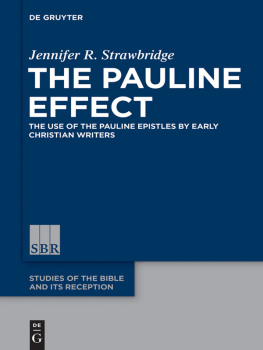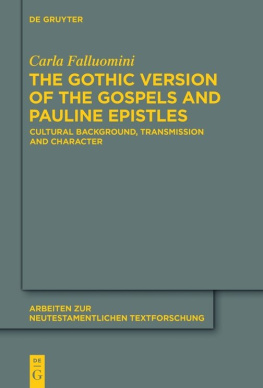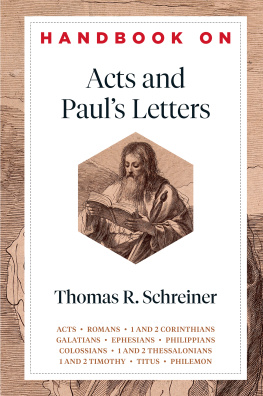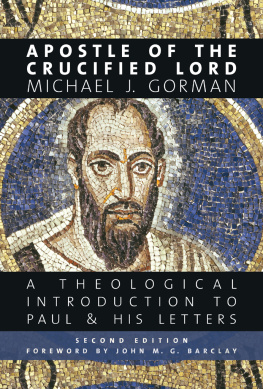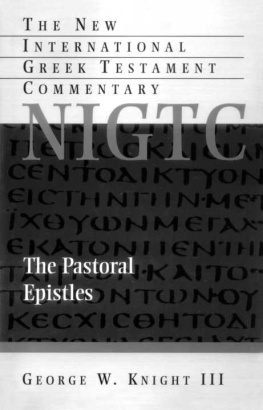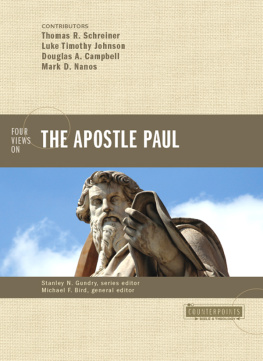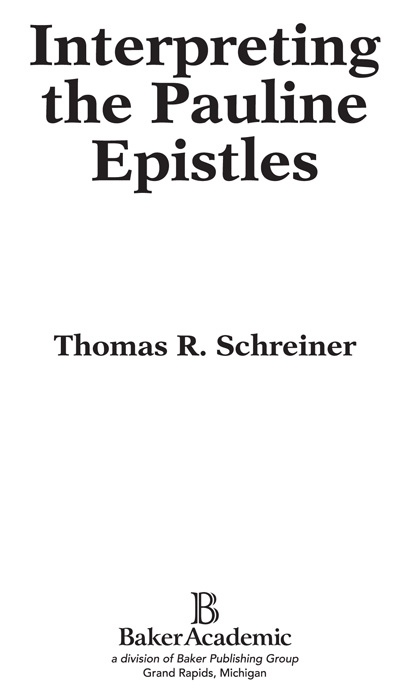
1990, 2011 by Thomas R. Schreiner
Published by Baker Academic
a division of Baker Publishing Group
P.O. Box 6287, Grand Rapids, MI 495166287
www.bakeracademic.com
Ebook edition created 2012
All rights reserved. No part of this publication may be reproduced, stored in a retrieval system, or transmitted in any form or by any meansfor example, electronic, photocopy, recordingwithout the prior written permission of the publisher. The only exception is brief quotations in printed reviews.
eISBN 978-1-4412-3639-5
Library of Congress Cataloging-in-Publication Data is on file at the Library of Congress, Washington, DC.
Unless otherwise indicated, Scripture quotations are from the Holy Bible, New International Version. NIV. Copyright 1973, 1978, 1984 by Biblica, Inc. Used by permission of Zondervan. All rights reserved worldwide. www.zondervan.com
Translations in the diagrams and charts are by the author.
To my wife, Diane, my fellow heir in the greatest cause
Contents
Preface to the Second Edition
I am grateful to Jim Kinney from Baker Academic for inviting me to prepare a revised edition of this book, and thanks also to Wells Turner for his excellent job in editing the current edition. It is tempting to enlarge the book significantly, but I believe the book has continued to be read because of its brevity. Hence, the purpose of the revision is to update the book where necessary, especially in terms of bibliography. The book has not changed dramatically, for I am still convinced that the substance of what I wrote some twenty years ago is correct. Nevertheless, the entire book has been revised, and there are some significant additions. The original edition presented the diagrams in Greek but not in English, and thus English has been added to enable readers to understand diagramming conventions. I am particularly thankful for the help of my research assistant, Greg Van Court, who helped with the bibliography, the Greek and English diagrams, and other details so that this revised edition would see the light of day. When this book was first written, I had three sons, but the Lord has since blessed us with a beautiful daughter as well. I am immensely grateful for the gift that my wife, Diane, and our four children (Daniel, Patrick, John, and Anna) have been to me.
Soli Deo gloria
Preface to the First Edition
Writing a book makes one very conscious that no book is ever written by one person alone. I am grateful to Scot McKnight for his thoughtful comments on earlier editions of the work. His criticisms were always penetrating and kind. My colleague at Bethel, Robert Stein, read the entire manuscript with his usual care and saved me from many errors. Another colleague, James Brooks, read my chapters on textual criticism and diagramming, providing invaluable advice on each.
Tom Steller, one of my pastors at Bethlehem Baptist Church, has been not only a friend who displays the warmth and gentleness of Christ, but he also taught me how to trace the argument of a passage (see the method described in chap. 6). A special thanks is due to Dan Fuller of Fuller Seminary, for the method used in chapter 6 ultimately comes from him. He also gave me the permission to disseminate it in this book. I have also benefited from his system of diagramming. Dan read the chapters on diagramming and tracing the argument with an eagle eye, thereby detecting many problems; he helped make this book much better than it would have been otherwise. I should say, however, that I have not followed all of his advice, and thus any errors in those chapters should be laid solely at my feet.
It was a joy to work with my editor from Baker, Gary Knapp. He improved the book in countless ways, for which I am grateful. This book also evinces a dependence upon my mentor from Fuller Seminary, Don Hagner. His New Testament Theology and Exegesis class influenced me significantly, and the annotated notebook he has compiled has been consulted again and again. Mark Reasoner, a colleague at Bethel College, read about half the manuscript, and I have incorporated some of his insightful suggestions, especially in regard to bibliographic material. I do want to say, and not just for perfunctory reasons, that any shortcomings in the book are mine alone. None of the people mentioned above would agree with everything said in this book, and yet all of them have made this book better than it would otherwise be.
My final and most important thanks are extended to my wife, Diane. She constantly reminds me that biblical scholarship is a noisy gong and clanging cymbal if the church of Christ is not edified. She and my three boys, Daniel, Patrick, and John, often drew me away from this book, not by nagging me but by delighting me with their own joy of life and joy in God. To God be the glory!
Abbreviations
General and Bibliographic
| BDAG | W. Bauer, A Greek-English Lexicon of the New Testament and Other Early Christian Literature , trans. and adapted by W. F. Arndt and F. W. Gingrich, 3rd ed. rev. and augmented by F. W. Gingrich and F. W. Danker (Chicago: University of Chicago Press, 2000) |
| ESV | English Standard Version |
| JSNTSup | Journal for the Study of the New Testament: Supplement Series |
| KJV | King James Version |
| LXX | Septuagint (the Old Testament in Greek) |
| mg. | marginal note |
| MS(S) | manuscript(s) |
| NA | Novum Testamentum Graece , edited by Eberhard Nestle, Erwin Nestle, B. Aland, K. Aland, J. Karavidopoulos, C. M. Martini, and B. M. Metzger, 27th ed. (Stuttgart: Deutsche Bibelgesellschaft, 1993) |
| NASB | New American Standard Bible |
| NET Bible | New English Translation |
| NIBCNT | New International Biblical Commentary on the New Testament |
| NICNT | New International Commentary on the New Testament |
| NIGTC | New International Greek Testament Commentary |
| NIV | New International Version |
| NKJV | New King James Version |
| NRSV | New Revised Standard Version |
| NT | New Testament |
| OT | Old Testament |
| papyrus |
| RSV | Revised Standard Version |
| SBLDS | Society of Biblical Literature Dissertation Series |
| SNTSMS | Society for New Testament Studies Monograph Series |
| UBS | The Greek New Testament , edited by B. Aland et al., 4th rev. ed. (Stuttgart: Deutsche Bibelgesellschaft and United Bible Societies, 1994) |
| WUNT | Wissenschaftliche Untersuchungen zum Neuen Testament |
| ZNW | Zeitschrift fr die neutestamentliche Wissenschaft und die Kunde der lteren Kirche |
Old Testament
| Gen. | Genesis |
| Exod. | Exodus |
| Lev. | Leviticus |
| Num. | Numbers |
| Deut. | Deuteronomy |
| Josh. | Joshua |
| Judg. | Judges |
| Ruth | Ruth |
| 12 Sam. | 12 Samuel |
| 12 Kings | 12 Kings |
| 12 Chron. | 12 Chronicles |
| Ezra | Ezra |
| Neh. | Nehemiah |
| Esther | Esther |
| Job | Job |
| Ps./Pss. |
Next page



